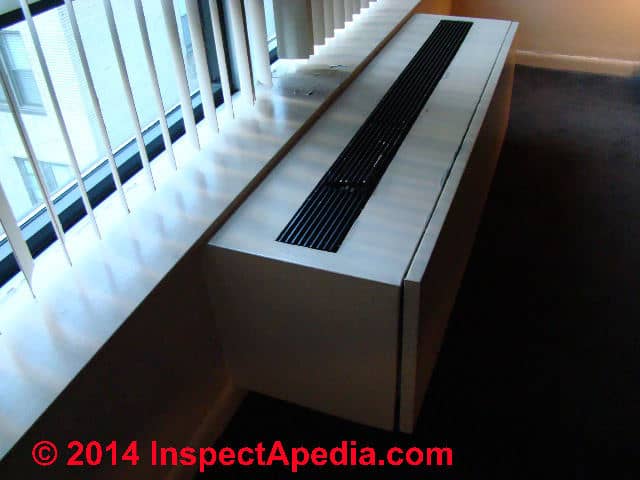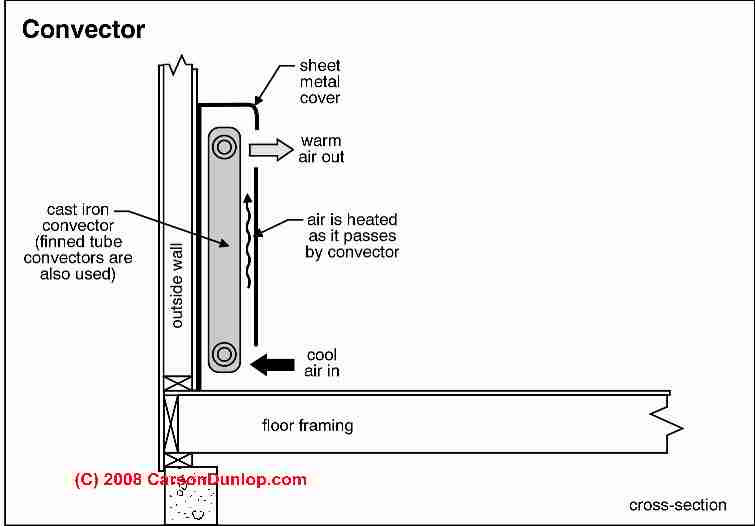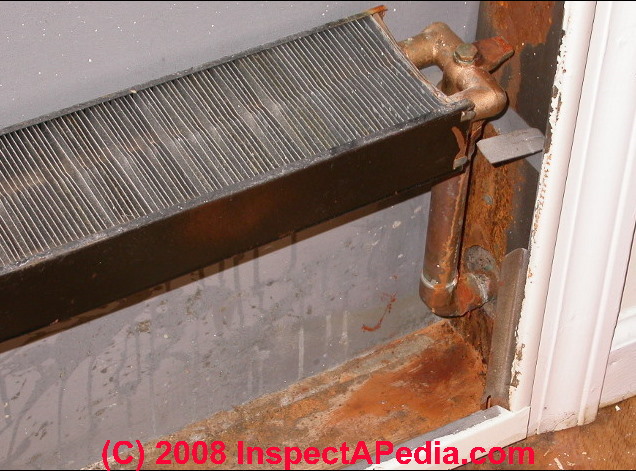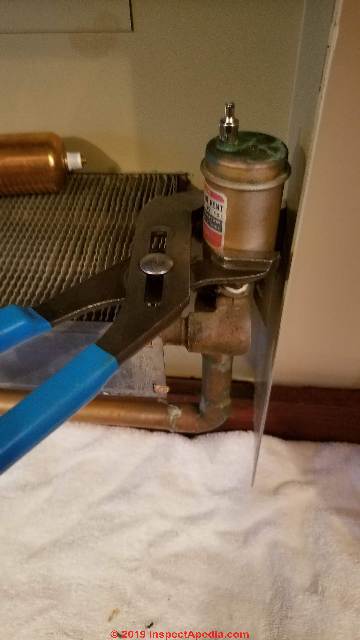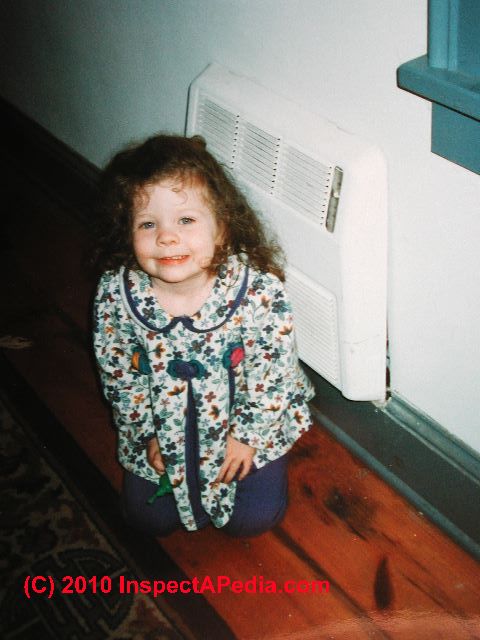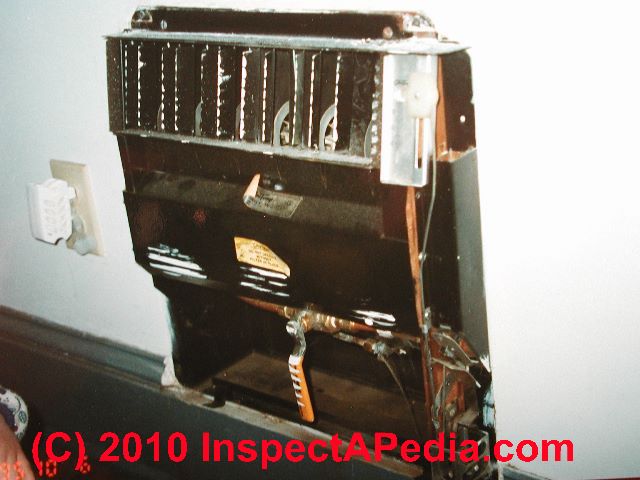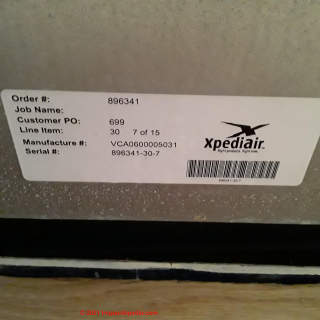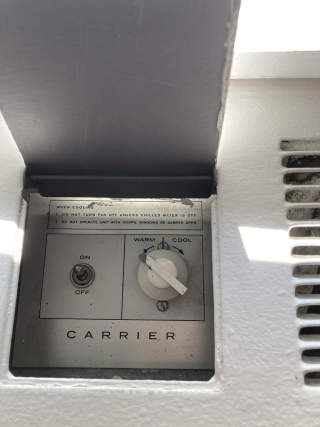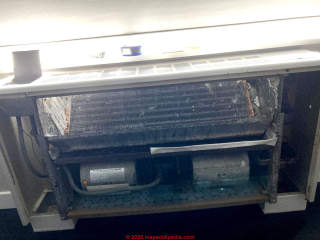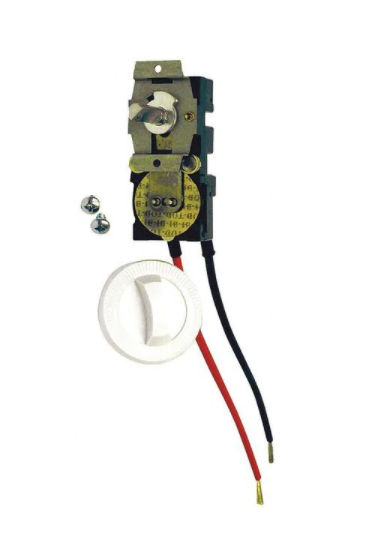 Wall Convectors for Air Conditioning & Heating
Wall Convectors for Air Conditioning & Heating
Finned heating or cooling convector units
- POST a QUESTION or COMMENT about heating convectors and air conditioning convectors that are wall-mounted
Wall convectors for heating or cooling.
This article describes wall convectors used for building air conditioning or heating. A wall convector is a wall-mounted unit that provides cool air or warm air to the building interior. The convector unit may be a horizontal unit, a vertical unit, or a smaller convector may be suspended from a ceiling.
The wall convector may be a fully self-contained independent unit or it may be connected to a building central cooling (water, refrigerant) or heating (water, steam, electricity) source.
Page top photo: the repair technician is disassembling a wall heating and cooling convector unit for inspection and repair.
InspectAPedia tolerates no conflicts of interest. We have no relationship with advertisers, products, or services discussed at this website.
- Daniel Friedman, Publisher/Editor/Author - See WHO ARE WE?
Guide to Wall Convectors used for air conditioning cooling or heating
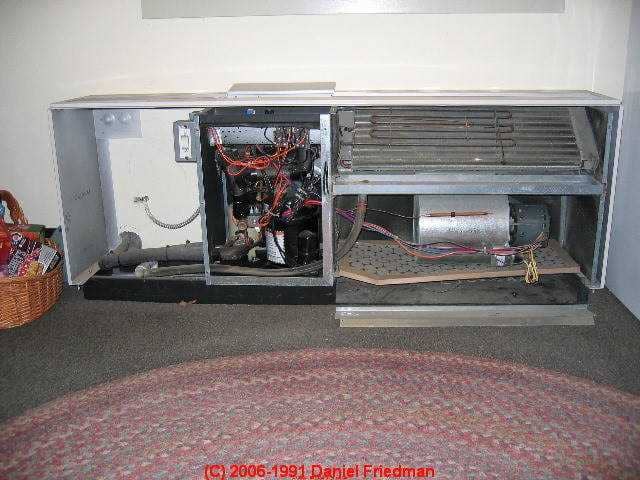 Here we describe types of cooling and heating wall convectors and common troubleshooting steps, inspection points, and repair suggestions. We also provide links to convector air conditioning/heating unit suppliers, manufacturers, and manuals.
Here we describe types of cooling and heating wall convectors and common troubleshooting steps, inspection points, and repair suggestions. We also provide links to convector air conditioning/heating unit suppliers, manufacturers, and manuals.
Article Contents
- A/C or HEAT WALL CONVECTOR INSPECTION
- FAN / WALL CONVECTOR OPERATION
- FAN / WALL CONVECTOR MAINTENANCE
- CONVECTOR UNIT CONDENSATE DRAINS & PANS
- CONVECTOR UNIT LIFE
- CONVECTOR UNIT MANUALS & SOURCES
Wall convectors are often used for both heating and cooling in commercial installations and high-rise apartment buildings.
The unit shown above has its own compressor mounted right in the cabinet, visible at lower center in
the photo.
Wall-mounted heating and cooling convector installations may be designed with one central heater or
cooling system which feeds multiple units with chilled or heated water
or possibly refrigerant from a single remote heating and cooling heat pump.
...
Air Conditioner or Heater Wall Convector Unit Blower Fan Inspection & Diagnosis
Wall-mounted heating and cooling convector installations may be designed with one central heater or cooling system which feeds multiple units with chilled or heated water or possibly refrigerant from a single remote heating and cooling heat pump.
Above is an enclosure for a Command Aire wall convector heating or cooling convector unit, ca 1980. You won't know just what's installed inside that cover without a bit of further investigation. We discuss this unit and its identification
at DATA TAGS on AIR CONDITIONERS.
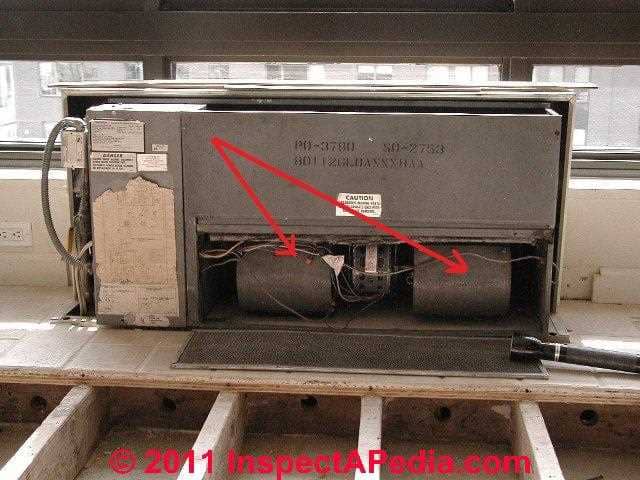
Our photo (above illustrates dual squirrel cage blower fans typically found in the bottom of a fan/convector heating or cooling unit such as this one found in a New York City apartment.
If the convector fan motors run and the squirrel cage fans spin but not enough air is coming out of your convector unit, turn off power and take a closer look at the fan blades themselves - you may need a flashlight and a mirror to make this check without disassembling the unit further than shown here (we removed the convector unit cover).
Dirt on the fan blades can significantly reduce airflow through the unit. Also check the cooling or heating coil fins for blockage by dust and debris - a more common source of air flow blockage at heating and cooling convector units like the one shown.
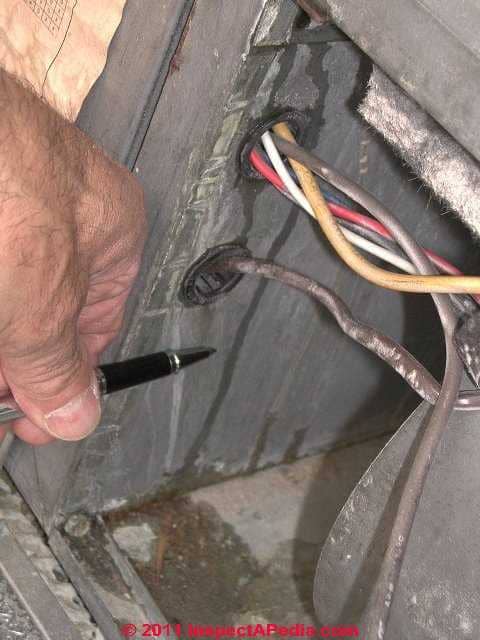
Our photo (above left) illustrates a condensate handling problem in the cooling convector unit for the same apartment unit introduced above.
Air conditioning condensate was leaking inside of the convector unit due to a clogged condensate drain line.
The condensate leak exited the bottom of the convector, ran through a raised floor cavity, entered apartment building walls, and ran around the wall interiors in a metal stud-framed wall sill plate where it led to major toxic mold contamination over a wide area, floor damage, and the need for costly cleanup and repair work.
Also
see CONDENSATE HANDLING, HVAC for more about air conditioner or heat pump condensate drainage handling.
...
How Do Heating Wall Convectors Work?
While wall convectors are widely used for combination heating and cooling systems, their energy sources vary and include chilled water as well as refrigerant for cooling, while the heat source in a wall-convector may be forced hot water, gravity hot water, steam, or the unit may be heated by electricity.
Many small wall convectors and some other convector units may incorporate a blower fan to increase the heat output from the device.
Above, courtesy of Carson Dunlop Associates, a Toronto home inspection & education firm, we see a schematic of how a wall-mounted heating or cooling convector unit works. This unit is passive, operating by simple convection.
The heat source in a wall-convector may be forced hot water, gravity hot water, steam, or the unit may be heated by electricity.
Above is a traditional hydronic heating system wall convector and inside we give a closer view of the heat exchanging finned tubing that warms air that moves by convection across that component.
These photos were taken in a 1920's home restored by the author on Vassar Road in Poughkeepsie New York.
A heating convector unit operates much like a radiator (page top photo) but instead of thick cast iron used to radiate heat, the convector is made of copper tubing covered with metal fins, or of cast iron with cast-in fins.
Our photo (above) shows a leaky heating convector that was recessed into the wall.
Below: a common leak point at hot water based heat convectors is at the air purge or air eliminator such as shown below:
See that repair detailed at AIR ELIMINATOR / FLOAT VENT REPLACEMENT
While recessed heating convectors were popular for aesthetic reasons (no radiator projects into the room), often a high percentage of the heat is flowing through the exterior wall to outside.
Our photo illustrates a steam-heated wall convector unit in a 1960's home found in New York. Steam convectors operate much like the hot water convector shown earlier but will include different relays and controls to manage the heat output of the unit.
This heating convector was wall-recessed and included an electrical blower fan.
Electric-heated wall convectors and some other convector units may incorporate a blower fan to increase the heat output from the device.
Our photographs of a wall-mounted heating convector (above and below) show a convector wall unit that is heated by steam.
Conventional wall-mounted heating convectors (units that do not include a fan or blower) rely on natural movement of warm-air upwards to draw cooler air in from the floor level.
You'll notice that there is a very generous air intake space along the bottom of the convector - it is designed to move plenty of air across its heating coil. As the convector gets hot, cool air is drawn up from floor level, is heated by the fins on the convector, and warm air is supplied out of the convector's front grille.
Watch out: if the convector fins are blocked by dust and debris or if the air inlet or outlet at the convector bottom or top are blocked by modifications, carpeting, furniture, the heating or cooling output of the device will be very significantly reduced. We discuss this problem in more detail
at RADIATOR BASEBOARD or CONVECTOR COVERS.
Below we provide articles that help in diagnosing and repairing no-heat problems with each of these types of heat delivery systems.
Other antique floor or wall heaters or convectors are shown
at ANTIQUE HEATERS STILL in USE
and
at AGE of HEATERS, BOILERS, FURNACES
Fan-Driven Heating Convector Units
Electrically-heated, steam heated, or hot water heated fan convector heating units similar to what you see in our photos here but boosted by a fan that blows room air across the heater are discussed
...
Wall Heating Convector Heater Maintenance
Once every year or so, we like to take the covers off of heating convectors to inspect the unit for leaks.
While we're at it, we make certain that the heat exchanging fins on the heating convector are not dust-clogged (photo at left). If your building is occupied by pets who shed much hair this step can be very important.
Getting good air flow through the heat exchanging fins of all finned heat exchanging devices such as heating convectors or finned copper tubing heating baseboards can make a significant difference in liberating the heat output from the device.
Just gently vacuum off the convector using a brush attachment and your vacuum cleaner - take care not to bend the fins.
A heating service contractor can provide more aggressive cleaning using special products, but on residential heating equipment that has not been exposed to some unusual problem we usually don't find it necessary.
...
Convector Unit Condensate Drains & Drain Pans
How to make or buy a replacement convector unit condensate pan
Reader Question: I need to find someone who can make a condensate pan and attach new fans and motor. Could be very large project as whole building needs this repair and I am trying to get quotes.
I posted pictures (3) of our unit on 7/10/20 as anonymous by accident.
Carrier has been no help and we are having problems finding parts like motors and the current pan are all starting to leak from age/rust etc.
For labor pricing etc figure worth to have new pan installed with attached fans and motor as labor would be cheaper and they are very old (1970's). Thanks for any help or leads. -
On 2020-10-06 by Mike
Reply by danjoefriedman (mod) - find someone who can make a condensate pan and attach new fans and motor
Hi Mike;
Your photos from 7/10/2020 are indeed included on the page above.
It's disappointing that you're not getting help from your local Carrier dealer. Have you tried contacting the company for advice or another referral?
Is this a commercial installation (as it sound?) If so a local residential contractor may not feel up to tackling the job.
I'd look for a commercial HVAC contractor in your country and city (not specified here).
Possible bad condensate drain installation on convector unit
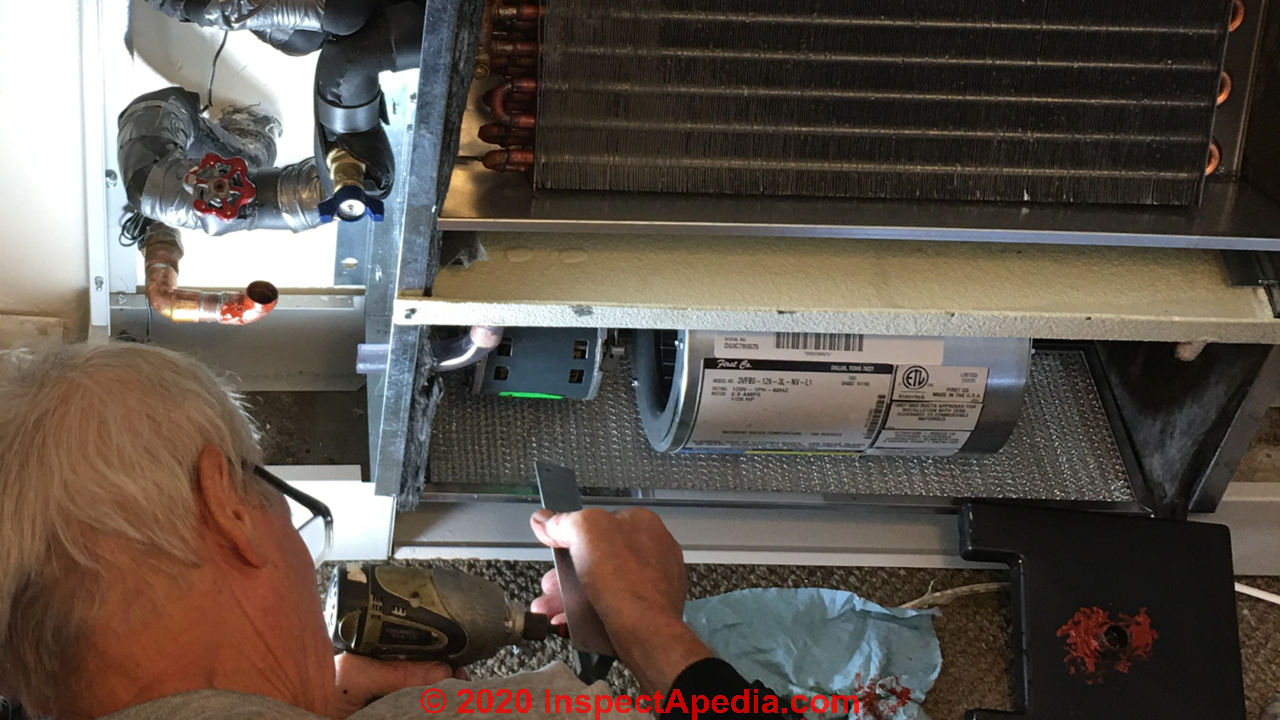 Reader question: We just had a new convector unit installed in our condo and it appears that the drain pipe (see picture, the drain pipe is the open-ended copper pipe with the red adhesive on the end) which comes out of the wall is about the same level as the condensate pan that is under the coils.
Reader question: We just had a new convector unit installed in our condo and it appears that the drain pipe (see picture, the drain pipe is the open-ended copper pipe with the red adhesive on the end) which comes out of the wall is about the same level as the condensate pan that is under the coils.
Instead of lowering the drain pipe, the plumber jury-rigged the black plastic drain pan (bottom right of the picture, on the floor) by cutting a hole through the the side of it and threaded the clear condensate pan hose through the hole, and installed a block of wood to hold the black drain pan at the right "angle" to allow condensate to flow from the clear hose to the black pan and down the drain pipe.
The black drain pan was glued to the drain pipe with adhesive.
This doesn't seem like the right setup to me as the drain pan is usually an inch or two below the condensate pan, to allow gravity to flow the water from the condensate pan to the drain pan.
Shouldn't the plumber fix the drain pipe itself by lowering it down to make the black drain pan below the condensate pan, thus allowing gravity to make the water flow out properly? -
On 2020-08-25
by Jason
Reply by (mod) -
Jason
When condensate can't drain by gravity into the drain system and where re-plumbing the drain is an onerous task, the simplest solution that might yet fit in your convector unit is to install a small condensate pump.
But I'm not sure from your photo that the pan under the cooling coil can't drain by gravity into the drain.
...
HVAC Convector Life Expectancy
Question: What is the life span of a convector?
The co-op I am in was built in 1963 and feel that after all these years the board needs to replace them.
Is it possible for convectors to burn out after time or not live up to it's full potential? - 2016/07/08 Louis said:
Reply:
Louis,
A convector doesn't "burn out" but depending on just what parts it contains, individual parts such as a valve, air bleeder, or blower motor may indeed need replacement. (Not all convectors use these parts.)
So, as Mark Cramer says, it depends. If the convector includes an electric motor-operated blower fan or relays those might fail with age; but generally you're talking about a set of finned tubing across which air moves to deliver warmed or cooled air to the occupied space.
My OPINION is that it would not be cost-justified to replace convector units based solely on age.
The fluid, refrigerant, or heating water, or steam depending on what convectors you actually using, varies in corrosivity and thus effect on convector life.
Refrigerant is virtually neutral - not corrosive unless the system is contaminated with other substances.
Water in a hydronic system is usually the same liquid re-used, and can be tested and managed for corrosivity by additives and treatments.
Steam condensate also needs to be managed for corrosivity by additives or treatments as is standard practice for steam heating systems.
If an individual convector fails because of mechanical damage or abuse that doesn't predict failure of the remaining units.
However if on inspection of convectors that are failing we found particular patterns of failure such as corrosion and resultant leaks on the failed units, I'd then suggest that your condo or co-op board needs to budget for a staged replacement of the units.
Research on convector unit life
- AIR CONDITIONER/ HEAT PUMP LIFE EXPECTANCY - article at InspectApedia.com
- Leyten, Joe L., and Stanley R. Kurvers. "Robustness of buildings and HVAC systems as a hypothetical construct explaining differences in building related health and comfort symptoms and complaint rates." Energy and Buildings 38, no. 6 (2006): 701-707.
- Na, Yeon-Jeong, Eun-Ji Nam, and In-Ho Yang. "Life Cycle Cost Analysis of Air Conditioning Systems in a Perimeter Zone for a Variable Air Volume System in Office Buildings." Journal of Asian Architecture and Building Engineering 9, no. 1 (2010): 243-250.
- Prek, Matjaz. "Environmental impact and life cycle assessment of heating systems." In Sustainable Building 2002 International Conference Summary Book, p. 360. 2002.
Excerpt: Life cycle assessment is defined by ISO 14000 series standards and is conducted by compiling an inventory of relevant inputs and outputs of a product system by evaluating the potential environmental impacts associated with the inputs and outputs and by interpreting the results of the inventory analysis and impact assessment phases. - Prek, Matjaz. "Environmental impact and life cycle assessment of heating and air conditioning systems, a simplified case study." Energy and Buildings 36, no. 10 (2004): 1021-1027.
- Yang, Lijun. "Life cycle analysis of the residential HVAC systems in Montreal." PhD diss., Concordia University, 2005.
...
Heating & Cooling Convector Manufacturers, Suppliers, Manuals
- Amana Packaged Terminal Air Conditioner (PTAC) Convector Units - contact acwholesalers.com
- Apollo Floor Fan Coil Units - distributed by MBTEK
- Beacon Morris, CONVECTOR UNIT INSTALLATION & OPERATION MANUAL [PDF] Beacon Morris (USA) 260 North Elm St., Westfield MA 01085 USA Tel: 413-568-9571
Beacon Morris (Canada), 7555 Tranmere Dr., Mississauga ON L5S1L4 Canada
Beacon Morris is a Mestek Company, website: www.mestek.com retrieved 2020/06/23, original source: http://mesteksa.com/fileuploads/Literature/BeaconMorris/CIOM-1.pdf - Comfor-Aire convector units, floor/ceiling mount units - contact SupplyHouse.com
- ConvectAir wall convectors Convectair NMT Inc. 30, carré Sicard Sainte-Thérèse (Québec) Canada J7E 3X6 Phone 450-433-5100 or toll-free : 1 800-463-6478 Fax 1-877-434-3166 Email support@convectair.ca Tel:+1 800 463-6478 Web: https://www.convectair.ca/en/products/convection
- Foter flat panel and other wall heaters, Website: https://foter.com/ [really annoying website - Ed.]
- GE PTAC Zoneline A/C with electric heat - Convector Units
- Empire Gas Frestanding Convector Heaters (Grainger Supply)
- Ideeco Baseboard & Convector Heaters (Electric) Sales Phone: 800.243.8162 Email: websales@indeeco.com Replacement Parts Phone: 314-644-4300 Ext 219 Email: parts@indeeco.com Visit our replacement parts page here. Technical Support Email: techsupport@indeeco.com
- Marley Convector Heaters incuding QMark, Berko, Faremheat and sill heaters, Email: mep.notices@marleymep.com(link sends e-mail) Fax:1+843-432-3199 Marley Engineered Products: Notice Department 470 Beauty Spot Road East Bennettsville, South Carolina 29512-2700 Unites States Technical Services Phone: 800-642-4328 Website: https://www.marleymep.com/
- Modine Steam / Hot Water Convectors, Modine Manufacturing Co.
1500 De Koven Ave.
Racine, WI 53403
1-800-828-HEAT (4328) Website: https://www.modinehvac.com/ the company provides a product literature library at https://www.modinehvac.com/resources/product-literature/
See this
MODINE STEAM / HOT WATER UNIT HEATERS Catalog [PDF] - Perfect Aire PTAC units includw wall mounted units
- Smith Environmental Products, Profile Fan Convector Units - sold at Home Depot stores
Excerpt: These fan convectors can be wall mounted or floor mounted. The BTU ranges from 3,000 BTU to 23,000 BTU/hour giving a fast and efficient way to heat up a space without taking up a lot of room. Great to use in porches, sun rooms, entry way, cellar, garages, mudrooms, walk-in closet, etc. - Smith Profile Hydronic Fan Convector Units / Convectors - Contact Riverbend Home
Excerpt: This Profile series PSU23 fan convector is a slim surface-mounted unit with a base skirt that allows it to be either wall or floor mounted. The unit provides fast, efficient heating of rooms where space is at a premium. Ideal for porches, sun rooms, entry ways, basements, garages, and other areas.
Also contact Global Industrial - Stelpro Convectors & Radiant Heaters, Tel: 450-441-0101 1 844 STELPRO (783-5776) https://www.stelpro.com/en-US/heating/convectors-and-radiant-heaters
- Steibel Eltron, Website: WALL MOUNTED CONVECTOR INSTALLATION & OPERATION MANUAL [PDF] https://www.stiebel-eltron-usa.com/products/cns-e-wall-mounted-convection-heaters
- TPI Institutional Wall Convector (Global Industrial at https://www.globalindustrial.com/ )
Excerpt:
INSTITUTIONAL WALL CONVECTOR HEATERS 2000 Watt Heater 480V
Institutional wall convector heaters provide low operating temperatures with tamper proof construction. Single phase institutional convector heaters are made using 11 gauge perforated steel housing with a textured ivory powder coat finish.
The tamper proof control panel on the left side houses a built-in single pole low voltage thermostat with 50-90° F temperature range and disconnect switch.
These convection heaters feature linear limit type thermal overload with automatic reset.
Wall convector heaters have a stainless steel element with aluminum fins. Convection wall heaters require a minimum of 4" from the floor and 12" to left side.
Heaters measure 5"D x 18"H. UL listed. 1 Year Limited Warranty.
...
Reader Comments, Questions & Answers About The Article Above
Below you will find questions and answers previously posted on this page at its page bottom reader comment box.
Reader Q&A - also see RECOMMENDED ARTICLES & FAQs
Question: replacement for ExpediAir wall convector unit?
My apartment built in 1962 has xpediar heat/AC horizontal convectors with no thermostat just 3 levels fan switch
. I would like to install a thermostat. Do you know where I can get the wiring diagram? Can I just use the:EG zoro.com sells this Cadet ComPack SP Built - In Stat Kit - Claude May 2020
Moderator reply:
Correct me if I've misunderstood, but I think that if you've already got a switch that controls fan speed for your heating/AC convectors, and if that switch is a line voltage (120VAC) control, you'd simply install a 120VAC line-voltage thermostat ahead of the fan control switch, using it to interrupt power to the fan switch.
When the thermostat isn't calling for heating or cooling the fan won't run, etc.
Details are at LINE VOLTAGE THERMOSTATS
Condo HOA wants to get rid of pneumatic controls for replacement thermostat controls for convector heaters/air conditioners
Hello. I am serving on the condo engineering committee for our HOA. Question.
We have a 1965 high-rise residential condo that still has a 2 pipe hvac system. The system has conditioned air from a main air handler - conditions and dehumidifies air to each residential unit. In each unit we also have a convector with a pneumatic temp controller.
Hot water in heating season and chilled water in cooling season are delivered to the residential convectors which allows additional suplemental heating or cooling.
A good many of us have 1/4 return valves to turn the water on or off in the convectors since the pneumatic controllers have mostly failed. Are there newer, retrofit options for thermostatic controllers out there that could replace these valves?
Would like to get away from the pneumatics and go to a better thermostat than can control the flow of water for individual unit comfort. - On 2021-01-17 by Richard Maiden
Moderator reply: newer, retrofit options for thermostatic controllers to replace pneumatic units
Sure, Richard; stop by your local heating supplier to see what they have at hand. There are both wired and wireless controls (wired systems would be much harder to retrofit for pneumatic-controlled sysetms) that can in turn operate the individual convector.
Usually the least-costly repair is to fix problems such as leaks or stuck or failed controls in the existing pneumatic system. IMO having a mix of some pneumatic and some "other" controls on your HVAC systems will become a maintenance nightmare and may increase service costs.
However for your purposes you'll probably want to look at wireless conrols.
Johnson Controls, Siemens, Honeywell, and others still make pneumatic controllers (a bit costly compared with a conventional thermostat but perhaps less costly than retrofitting the whole system with alternative controls.)
These references may be useful both as offering some alternatives and also for putting you into contact with industry experts who can give you more detailed help than can I. - On 2021-01-18 by (mod)
- Cypress Energy Systems, Retrofitting Existing Buildings for Demand Response & Energy Efficiency [PDF] PPT presentation, Website: www.cypressenvirosystems.com
- ICE AIR PTAC REPLACEMENT & RETROFIT (Brochure) [PDF] original source: http://www.ice-air.com/wp-content/uploads/Ice-Air-Replacement-PTAC-brochure.pdf
- Shi, Xiangnan, IMPLEMENTATION OF OF INTEGRATED COMMISSIONING,
RETROFITS, AND CONTROL OPTIMIZATION PROCESS IN A
SMALL COMMERCIAL BUILDING [PDF] (2001) (Dissertation) University of Nebraska
Excerpt:
This thesis begins with a review of the applications for commissioning, retrofits, and control optimization of existing buildings. Then, to compare the conventional commissioning and retrofit process with integrated process, a case demonstration is applied to an existing small commercial building - Sine, Jack, MAKING PNEUMATIC THERMOSTATS ENERGY EFFICIENT [PDF] original soiurce: https://www.powerelectronics.com/technologies/alternative-energy/article/21852425/making-pneumatic-thermostats-energy-efficient
Email: email: usercare@penton.com
Sales contact: Elizabeth Eldridge (917) 789-3012 eeldridge@endeavorb2b.com
Excerpt:
A version of the Wireless Pneumatic Thermostat, or WPT , directly replaces a pneumatic thermostat and turns it into a BAS node.
Cost of a wall mounted air conditioner and heating system,
The cost of a wall mounted air conditioner and heating system, HVAC convector - On 2020-12-08 by Gerald.Ruscingno@shu.edu -
Reply by (mod) -
Gerald
I'll be glad to take a stab at your wall-mounted heating and air-conditioning question, but first we need some clarification.
Many convector units are simply the heating and cooling outlet for a central boiler or air conditioner system located elsewhere in the building, so the cost of such a system has to include the central equipment, the distribution piping, and then the cost of the individual HVAC convector unit(s) - that cost ranges far too widely by building size to make any sense out of an "out of the air" cost number pick.
Alternatively, you might be better served by one or a few wall-mounted split-system heat pump units that can provide both heating and cooling -
See SPLIT SYSTEM DUCTLESS AIR CONDITIONERS / HEAT PUMPS
Carrier wont talk to an individual and basically hung up on me
Carrier wont talk to an individual and basically hung up on me and lets face it, no local (chicago) repair person wants to deal with old convectors, they want to install new ones and are too busy to want to help repair something they dont know about.
That is why I am trying to find someone who can make a new tray assembly and sell to our condo building. With 200 units and 3-6 convectors per unit, it could be a big order once it is tested out.
Figure it was worth a shot posting here. If not have to find a local metal worker and start from there. Thanks! - 2020-10-06 by Mike - C
Reply by (mod) -
I don't know but I suspect that people whom you approach are going to look at this and say that the cost of the tray is trivial but the labour is enormous and they figure that the customers ultimately not going to go for it so they don't want to even waste their time examining and making a bid.
Bugs and rodents that enter co-op through the convectors?
What can be done about bugs and rodents that enter co-op through the convectors? - 2020-07-18 by M.H
Reply by (mod) -
M
A licensed pest control operator can find the actual points of entry and close them off. They may also proposal poisoning scheme but I would be very careful about using any toxic chemical or poison in any equipment that could blow air across the poison into the occupied space.
Heat/AC Convector suddenly stopped providing cool air unless in heat mode
Two pipe system for both ac ( using chilled water) and heat with separate thermostats in each room. Suddenly one convector in my condo stopped providing AC
but if you switch the thermostat to heat and adjust the temperature setting cool air comes out. Is the problem the convector of thermostat?
All other convectors in my condo are working. - On 2020-07-14 by Susan Fischer
Reply by (mod) -
That does sound like a bad control or relay.
I am guessing that when you put the unit into HEAT mode the blower runs but as your building is in cooling mode the water piped through the convector is cool not warm, so it's "cooling" in "heating mode".
Where to find the model number on a Carrier A/C convector unit
Opened up unit and not sure if this is the unit model number or just the fan blade. Model 42AB4R-1 27-2
Job# 1500E6060-015 02
Motor: volts 120-1-60. Amps. 1.70
Around 1970 made -
2020-07-10
by Anonymous
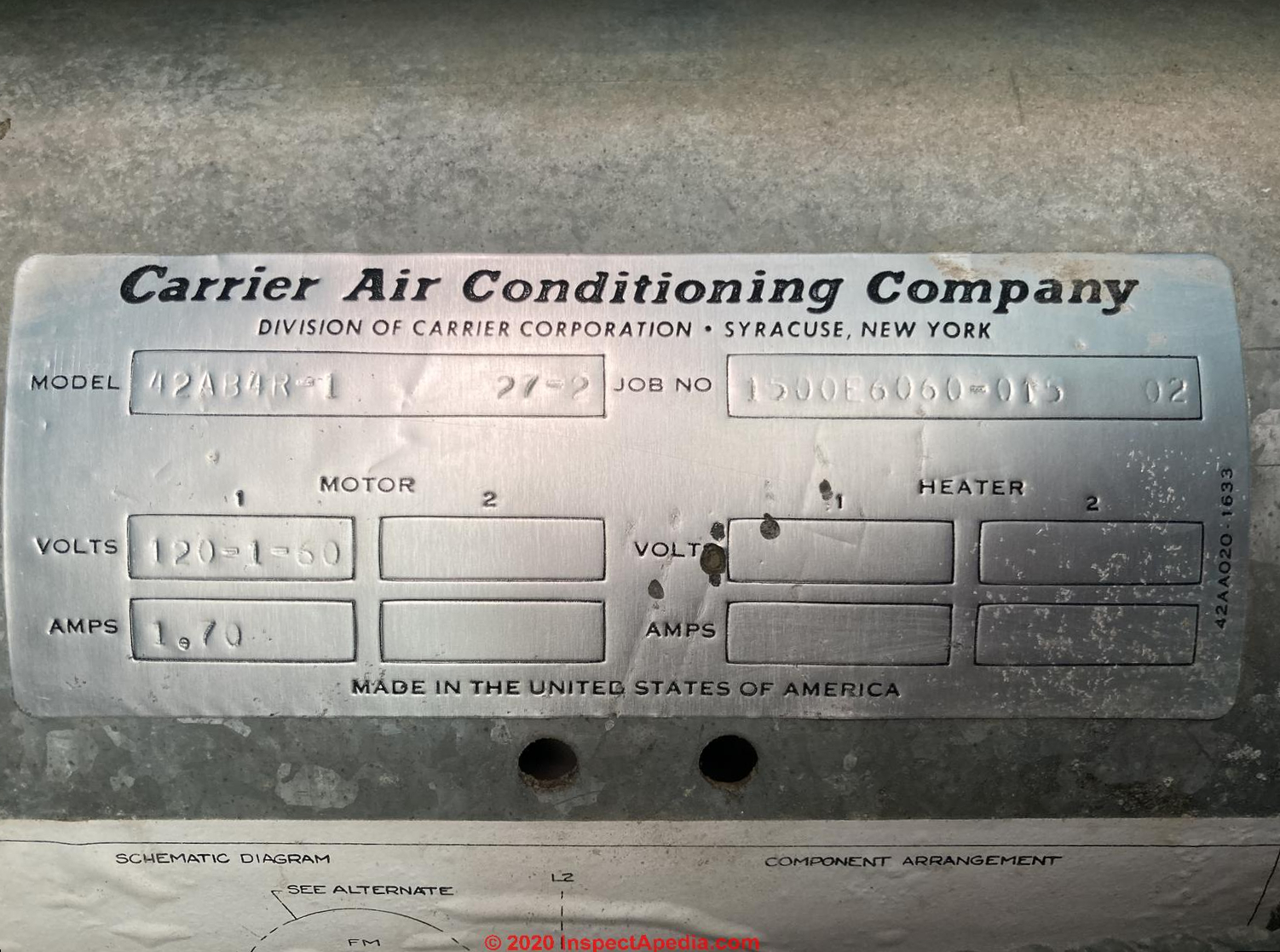
More photos of our Carrier A/C & heating convector unit are below:
...
I can't find a replacement air filter that fits my convector unit
I have an old convector unit with a removable filter on the bottom....what kind of replacement filter can I use? I can't seem to find what I'm looking for at Home Depot.
Any suggestions? - 2020-07-05 by Lauren
Reply by (mod) -
Lauren:
If you can find the brand and model of your convector we might find the user's manual to see what the manufacturer recommends.
Otherwise, if you have the old filter, either measure its dimensions or take it along to any building or HVAC supplier to match its dimensions. You'll probably find several air filters of varying ratings all of the same size.Take care not to install a too-high-filtration-rate air filter or the air flow from your unit may be blocked and the fan could overheat.
If you do not have the old air filter for your convector unit, measure the dimensions in length and width of the rack or slots into which the air filter would fit and use those to buy a replacement of the proper length, width, and thickness.
In the "worst case" of not being able to find an exact size match for your air filter there are cut-out- air filter kits that can work.
Watch out: especially with DIY cut-out air filter kits: the air filter has to be adequately supported so as not to be drawn into the fan - lest you block the fan and set it afire.
Please see details at AIR FILTERS for HVAC SYSTEMSOn 2020-07-05 2 by Lauren
Awesome - thank you SO much for all that information, it helps a lot! I can't find the brand of convector, but I'll be careful about any cut to size thanks to your warnings!
Need Cadet ComPack SP Built - In Stat Kit replacement
We have a 1970 hot/cold carrier convector and need to upgrade the thermostat. Is there anyone who can help?
Can do work myself If get the parts or conversion to use new style thermostat. Thanks! - On 2020-07-01
by Mike
Reply by (mod) - where buy a generic replacement thermostatic control for a convector unit
Mike
Have you got a model no. for the unit?
Spencer thermostat that's built into the unit or is it a separate wall thermostat? I'm guessing it's built in since the wall thermostat is pretty generic.Post a photo of the parts involved and I'll do some research. I can't tell from what you've said so far if we can use a generic replacement control or not.
EG zoro.com sells the Cadet ComPack SP Built - In Stat Kit shown above
Robertshaw, Cadet, Qmark, and others provide replacement thermostats - you'll need some details about what's being replaced
Followup by Mike
It is built in. Unfortunately I don’t see any model number listed. It has a toggle on off switch and a dial thermostat that outs the fan to high or low speed don’t think it actually changes temperature just fan speed. Thank you for replying
What's the hole in the outside wall below our convector A/C-Heat unit?
I own a rental apartment in a 1964 building that is heated and cooled by a convector unit.
There is a small (about 1" diameter) hole in the outside wall beneath the convector and the building supervisor told me that that is needed as a vent for the convector. I've never heard of having a vent with no cover or screen against insects, etc. Is this really a required thing? Thanks. -
On 2020-05-26 1 by Joel S
Reply by (mod) -
Joel that sounds odd to me, too. I'd like to see photos (one per comment) of the hole from outdoors and another of the convector from inside showing what's piped to that opening.
Perhaps it's a condensate drain?
Need to buy 3 convectors. Who sells International Environmental Company units?
HI,
I need to buy 3 convectors. Do you know who selsl International Environmental Company brand?
I need:
ONE 400 Right Drain Two Pipe Regular 1/2 Coil
ONE 400 Left Drain Two Pipe Regular 1/2 Coil
ONE 300 Right Drain Two Pipe Regular 1/2 Coil
Thanks,
Joev-
2019-06-01 by Joe Scott - I
Reply by (mod) - How to contact International Environmental Co. for replacement parts
Joe,
Have you checked with your local heating supplier to see what they can get you?
In order to absolutely assure our readers that we write and report without bias we do not sell any products nor do we have any business or financial relationships that could create such conflicts of interest.
InspectAPedia is an independent publisher of building, environmental, and forensic inspection, diagnosis, and repair information for the public - we have no business nor financial connection with any manufacturer or service provider discussed at our website.Joe: update on buying equipment from International Environmental,
you can contact the company directly at
Contact International Environmental Co. IEC
Main Phone: 405.605.5000
Mailing Address
5000 W. I-40 Service Road
Oklahoma City, OK 73128 USA
https://iec-okc.com/
What happens if the supply and return water pipes are backwards on a convector unit?
What happens if the supply and return water pipes are backwards - n 2019-05-23 by Anonymous
Reply by (mod) -
You'll get no heat on a call for heating
Best way to clean our moldy convector unit
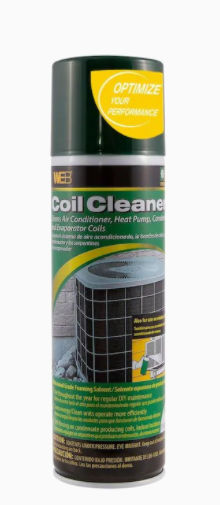 We have been noticing mold on inside and outside of convector. What is best way to clean? -
We have been noticing mold on inside and outside of convector. What is best way to clean? -
On 2019-05-08 by Anonymous
Reply by (mod) - Spray cleaners for Convector Unit Coils
Anon
Any household cleaner is fine for removing mold growth on a surface that can be washed and wiped.
If you are seeing moldy dust and crud on the actual finned convector itself then a commercial HVACR coil cleaner (typically foamand possibly a very gentle brushing - avoid fin damage) may be needed.
There are commercial HVAC coil cleaner liquids sold by any heating or air conditioning supplierand at many building supply stores as well as, for small jobs, sprays like this WEB Green White Aerosol Foam Coil Cleaner
Insulation for the convector unit cover to prevent mold
I have a convector in an apartment using central air (water) system. Inside of the convector cover was a patch of insulation that prevented mold from growing on the convector cover with an adhesive. Years ago being young and dumb, I ripped it off.
The room is now in use again and without that patch of insulation, mold grows on the cover during the summertime.
I have looked here and online and I'm still very stumped.
What kind of insulation can I get for the convector cover? It is a very similar setup as the first 2-3 photos above. Anything you can recommend I would greatly appreciate, thank you! -
On 2019-04-14
by Sandy
Reply by (mod) -
There are dense fiberglass mats that are sold as insulation for use inside of air conditioning and some heating systems, or you could look at some new equipment at Home Depot or Lowe's store to see what they're using, or you could probably find a thin fiberglass insulating panel that would work.
Watch out to be absolutely sure that you are not blocking any combustion air or you could make the system unsafe or even fatal.
...
Continue reading at FAN COIL & FAN CONVECTOR HEATERS & HYDRONIC COILS where we include heating output capacity tables, operating temperatures, flow rates, or select a topic from the closely-related articles below, or see the complete ARTICLE INDEX.
Or see WALL CONVECTORS HVAC FAQs - questions & answers about convector units posted originally at the end of this page.
Or see these
Recommended Articles
- AIR CONDITIONER/ HEAT PUMP LIFE EXPECTANCY
- AIR ELIMINATOR / FLOAT VENT REPLACEMENT - common leak point on water-type convecdtor units
- BLOWER FAN OPERATION & TESTING
- FAN COIL & FAN CONVECTOR HEATERS & HYDRONIC COILS
- NIGHT STORAGE HEATERS & HEAT SINK RADIATORS
- WALL CONVECTORS HVAC
Suggested citation for this web page
WALL CONVECTORS HVAC at InspectApedia.com - online encyclopedia of building & environmental inspection, testing, diagnosis, repair, & problem prevention advice.
Or see this
INDEX to RELATED ARTICLES: ARTICLE INDEX to HEATING SYSTEMS
Or use the SEARCH BOX found below to Ask a Question or Search InspectApedia
Ask a Question or Search InspectApedia
Try the search box just below, or if you prefer, post a question or comment in the Comments box below and we will respond promptly.
Search the InspectApedia website
Comments & Questions are Welcome Here
If you posted comments here and no longer see what you wrote, please check for your comment in the Reader Q&A found above on this page.
Citations & References
In addition to any citations in the article above, a full list is available on request.
- [1] "Air Conditioning & Refrigeration I & II", BOCES Education, Warren Hilliard (instructor), Poughkeepsie, New York, May - July 1982, [classroom notes from air conditioning and refrigeration maintenance and repair course attended by the website author]
- [2] Thanks to Mark Cramer, Tampa Florida, for assistance in technical review of the "Critical Defects" section and for the photograph of the deteriorating gray Owens Corning flex duct in a hot attic. Mr. Cramer is a Florida home inspector and home inspection educator.
- [3] Thanks to Jon Bolton, an ASHI, FABI, and otherwise certified Florida home inspector who provided photos of failing Goodman gray flex duct in a hot attic.
- [4] Thanks to Scott at SJM Inspect for suggesting this EPA document and for technical editing remarks regarding our air conditioning website, SJM Inspection Service LLC, serves the entire state of CT, sjminspect.com 203-543-0447 or 203-877-4774 5/16/07
- [5] Thanks to Joe Panimondo for technical editing, April 2011
- [9] HVAC Education, Training Accreditation agencies: Quoting the U.S. DOL HVAC website above::
After completing the programs below, new technicians generally need between 6 months to 2 years of field experience before they are considered proficient. Three accrediting agencies have set academic standards for HVACR programs:- [10] HVAC Excellence. 1701 Pennsylvania Ave NW,
Washington, DC 20006 Tel: (800) 394-5268. Quoting:
HVAC Excellence is a not for profit organization that has been serving the HVACR industry since 1994. It is our goal to improve competency through validation of the technical education process.
By setting standards and verifying that they have been met, we inspire the industry to excel. We know that all of the challenges that face our industry are achievable by continuous improvement in the way that we prepare technicians. - [11] National Center for Construction Education and Research, 3600 NW 43rd Street, Bldg. G, Gainesville, FL 32606, Tel: 888.622.3720, Quoting:
NCCER is a not-for-profit education foundation created to develop industry-driven standardized craft training programs with portable credentials and help address the critical workforce shortage facing the construction industry. - [12] The Partnership for Air-Conditioning, Heating, and Refrigeration Accreditation, (PAHRA)
2111 Wilson Blvd., Suite 500
Arlington, VA 22201-3001
(703) 524-8800, Quoting:
The Partnership for Air-Conditioning, Heating, Refrigeration Accreditation (PAHRA) is an independent, third party organization that is a partnership between heating, ventilation, air-conditioning and refrigeration (HVACR) educators and the HVACR industry that will award accreditation to programs that have met and/or exceeded industry validated standards.
This programmatic accreditation program is the only one that is supported by the major industry associations.
- [10] HVAC Excellence. 1701 Pennsylvania Ave NW,
Washington, DC 20006 Tel: (800) 394-5268. Quoting:
- [13]
HVAC Training Courses, Schools: HVAC Technician Training Schools [http://technicianschool.net/hvac-technician-training-schools/], lists the following schools offering technical courses may offer specific training programs for potential careers, including HVAC technicians. Among HVAC schools that website lists are
- Everest Colleges [http://www.everest.edu],
- Florida Career College 7891 Pines Blvd Hollywood, FL 33024 http:// www.careercollege.edu/,
- Lincoln Institute 2299 Vauxhall Road Union, NJ 07083 http:// www.lincolnedu.com/
- NOTE: when considering an HVAC training course or school, check the HVAC education accrediting associations listed above.
- [14] Ratib Bakera is member of Refrigeration Service Engineers Society (RSES), an International
training organization for the HVACR industry provides educational and certification programs to HVACR professionals of all experience levels. www.rses.org provides information on the organization and its training materials.
Independent testing and certification of HVAC technicians is provided by North American Technician Excellence - NATE - see www.natex.org. NATE is supported by ASHRAE, the US EPA, and a host of other trade and professional associations. - [15] Singer brand HVAC equipment brand history: Singer was bought by & became the climate control unit of Dallas-based Snyder General Corp. (founded by a former Singer HVAC manager) in 1982.
The name Singer was dropped in 1984. In 1984 Snyder General operations included Arcoaire, Comfortmaker, and McQuay. In 1991 Snyder General sold Arcoaire & Comfortmaker to Inter-City Products.
In 1994 Snyder General was acquired by Hong Leong Group Malaysia. Snyder General is at 2001 Ross Avenue Dallas, TX 75201. - [16] Lennox air conditioning and heat pump owners manuals for convector units as well as other Lennox air conditioners, air handlers, furnaces, heat pumps, indoor air quality systems, packaged units, water heaters, zone controls and other controls such as thermostats, are provided by Lennox at http://www.lennox.com
- [23] Air Diffusion Council, 1901 N. Roselle Road, Suite 800, Schaumburg, Illinois 60195, Tel: (847) 706-6750, Fax: (847) 706-6751 - info@flexibleduct.org - www.flexibleduct.org/ -
"The ADC has produced the 4th Edition of the Flexible Duct Performance & Installation Standards (a 28-page manual) for use and reference by designers, architects, engineers, contractors, installers and users for evaluating, selecting, specifying and properly installing flexible duct in heating and air conditioning systems.
Features covered in depth include: descriptions of typical styles, characteristics and requirements, testing, listing, reporting, certifying, packaging and product marking.
Guidelines for proper installation are treated and illustrated in depth, featuring connections, splices and proper support methods for flexible duct. A single and uniform method of making end connections and splices is graphically presented for both non-metallic and metallic with plain ends."
The printed manual is available in English only. Downloadable PDF is available in English and Spanish. - [24] Engineering toolbox properties of water - http://www.engineeringtoolbox.com/water-thermal-properties-d_162.html and email: editor.engineeringtoolbox@gmail.com web search 09/16/2010
- [25] Owens Corning Duct Solutions - www.owenscorning.com/ductsolutions/ - provides current HVAC ductwork and duct insulating product descriptions and a dealer locator. Owens Corning Insulating Systems, LLC, One Owens Corning Parkway, Toledo, OH 43659 1-800-GET-PINK™
- [26] "Flexible Duct Media Fiberglas™ Insulation, Product Data Sheet", Owens Corning - see owenscorning.com/quietzone/pdfs/QZFlexible_DataSheet.pdf
"Owens Corning Flexible Duct Media Insulation is a lightweight, flexible, resilient thermal and acoustical insulation made of inorganic glass fibers bonded with a thermosetting resin." - [27] Modern Refrigeration and Air Conditioning, A. D. Althouse, C.H. Turnquist, A. Bracciano, Goodheart-Willcox Co., 1982
- [28] Principles of Refrigeration, R. Warren Marsh, C. Thomas Olivo, Delmar Publishers, 1979
- "Air Conditioning & Refrigeration I & II", BOCES Education, Warren Hilliard (instructor), Poughkeepsie, New York, May - July 1982, [classroom notes from air conditioning and refrigeration maintenance and repair course attended by the website author]
- [29] Refrigeration and Air Conditioning Technology, 5th Ed., William C. Whitman, William M. Johnson, John Tomczyk, Cengage Learning, 2005, ISBN 1401837654, 9781401837655 1324 pages
- [30] Carson Dunlop, Associates, Toronto, have provided us with (and we recommend) Carson Dunlop Weldon & Associates'Technical Reference Guide to manufacturer's model and serial number information for heating and cooling equipment ($69.00 U.S.).
- [31] Air Conditioning SEER - New DOE Air Conditioner and Heat Pump Efficiency Standard
- [32] FlowKinetics LLC, 528 Helena Street Bryan, Texas 77801 USA, Tel: (979) 680-0659, Email: inform@flowkinetics.com, Website: www.flowkinetics.com, "FKS 1DP-PBM Multi-Function Meter Pressure, Velocity & Flow User’s Manual", web search 07/16/2012, original source: http://www.flowkinetics.com/FKS_1DP_PBM_Manual.pdf [copy on file] and "FKT Series Flow Measurement And Pressure Acquisition System User's Manual" http://www.flowkinetics.com/FKTSeriesManual.pdf [copy on file]
- [33] Histoire de l'Académie royale des sciences avec les mémoires de mathématique et de physique tirés des registres de cette Académie: 363–376. Retrieved 2009-06-19.- Pitot Tubes, Henri Pitot (1732)
- [35] "GE Zoneline® Owners Manual and Installation Instructions, Heat/Cool Model 2900, Heat Pump Model 3900", General Electric Corporation, [copy on file].
- [36] "GE Zoneline® Owners Manual and Installation Instructions, Heat Pump Model 5800", General Electric Corporation, [copy on file].
- [37] "Whirlpool WGPH45 Packaged Heat Pump, Product Specifications", Whirlpool Corporation, [copy on file]. Website: www.whirlpoolcomfort.com
- [38] N Lu, YL Xie, Z Huang, "Air Conditioner Compressor Performance Model", U.S. Department of Energy, August 2008, [copy on file as PNNL-17796.pdf] Available to the public from the National Technical Information Service, U.S. Department of Commerce, 5285 Port Royal Rd., Springfield, VA 22161 ph: (800) 553-6847, fax: (703) 605-6900 email: orders@ntis.fedworld.gov online ordering: http://www.ntis.gov/ordering.htm
- [39] Yinger R, R Bravo, and D Martinez. 2006 Air Conditioner Stalling Effects Study/Air Conditioner Testing Procedures. Southern California Edison, Rosemead, California
- [40] Bravo, R, R Yinger, and L Gaillac. 2006. Conditioner Stalling Unit Level Solutions Test Report. Southern California Edison, Rosemead, California.
- [41] Lu N, B Yang and Z Huang. 2008a. Evaluation of Southern California Edison Air-Conditioner Stalling Solutions. PNNL-17686, Pacific Northwest National Laboratory, Richland, Washington.
- [42] Danny S. Parker, John R. Sherwin, Bart Hibbs, "Development of High Efficiency Air Conditioner Condenser Fans", ASHRAE Transactions June 2005, [copy on file as FSEC-CR-1674-05.pdf]
- In addition to citations & references found in this article, see the research citations given at the end of the related articles found at our suggested
CONTINUE READING or RECOMMENDED ARTICLES.
- Carson, Dunlop & Associates Ltd., 120 Carlton Street Suite 407, Toronto ON M5A 4K2. Tel: (416) 964-9415 1-800-268-7070 Email: info@carsondunlop.com. Alan Carson is a past president of ASHI, the American Society of Home Inspectors.
Thanks to Alan Carson and Bob Dunlop, for permission for InspectAPedia to use text excerpts from The HOME REFERENCE BOOK - the Encyclopedia of Homes and to use illustrations from The ILLUSTRATED HOME .
Carson Dunlop Associates provides extensive home inspection education and report writing material. In gratitude we provide links to tsome Carson Dunlop Associates products and services.


